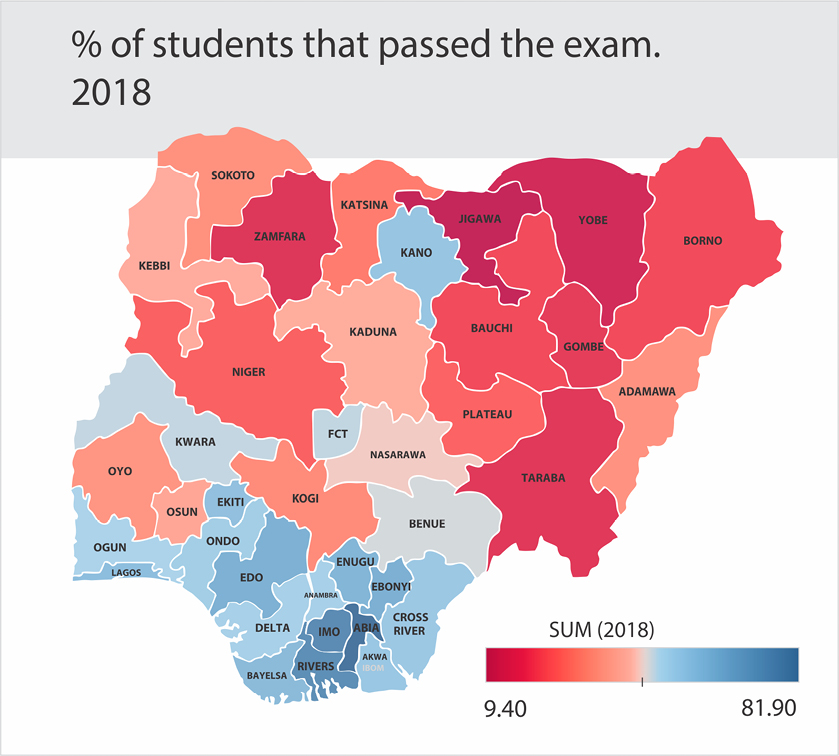The education gap between most states in the northern part of Nigeria and their southern counterparts is growing due to a number of reasons, including the inability of schools to cover syllabus early.
The problem, according to a senior secondary school student who prefers not to be named, is further compounded by lack of qualified teachers especially in core subject areas.
Students from well-to-do families resort to private extra lessons in a bid to close the knowledge gap and be able to compete with well-educated children from other parts of the country. The lessons run for 12 hours per week.

Meanwhile, the quest by the North to reduce the long-standing educational gap with its southern counterpart has suffered a significant setback in recent years, a Daily Trust analysis of secondary school-leaving examination results revealed.
The 2016-2018 figures, released by West African Examination Council (WAEC), showed that the number of students securing the minimum grade for university admission in the West African Senior School Certificate Examination (WASSCE) from northern Nigeria has been declining, so is the number of northern students that sat for the exam.
Another damning statistics, obtained from the National Bureau of Statistics (NBS), buttresses this challenge. The figures are coming at a time political leaders from the North are claiming to be working hard to improve the quality of education, while introducing additional measures in the effort to increase school enrollment rate and performance.
One analyst described the figures as “devastating and self-inflicting” for an area that has been behind its counterpart in western education since its inception, and torn apart by a decade of deadly Boko Haram insurgency and lack of coherent policy making and implementation strategy.
Education deprivation in the North has been linked to several factors, including poverty and socio-economic norms and practices that discourage the attendance of formal education.
Some have also linked it to the area’s initial reaction to the colonial masters who first stayed in the South before heading to the North.
Unlike the southerners who accepted the Europeans and embraced their ideals, the northerners resisted. They insisted on keeping their religion, trade, governance, reading and writing.
A decrease in national spending on education
Public data of the government’s budget shows that the allocation of public spending at the national level decreased by 11% in the 2016-2018 period.
In 2016, the federal government allocated 7.92% of the national expenditures to education. By 2018, that number decreased to 7.04% of the N8.6 trillion that the government of President Muhammadu Buhari proposed to spend on education.

As the national education budget shrinks, the North takes the fall
Our analysis of the data put together for private and public schools shows that Nigeria’s southern region has the highest rate of students that scored five credits and above, including English and Math. The main requirement for university admission is five credits, including Math and English.
However, students who fail in the WAEC exam could still get admission into the university if they meet the same requirements in their Senior School Certificate Examination prepared by the National Examinations Council (NECO), a Nigerian equivalent of the WAEC.
The following chart shows the percentage of students who received five credits, including Math and English in each region, including Abuja. It is noticeable how the North (coloured red) is underperforming and how the South has a better rate of approved students than the national average.
In 2018, for instance, out of 1,006,688 southern students that sat for the exam in public and private schools, 56% of them got five credits and above, including English and Math.
The North, in comparison, had 206,183 out of 630,971 or 32% that got the same score of five credits and above.
As seen in the graph, this rating is below the national average of 47%. The North also had the lowest number of students that sat for the crucial exam.
Meanwhile, the capital city, Abuja, which is treated separately in this analysis, had 23,622 students that sat for the exam and 52% among them had five credits and above, including English and Math. This means that the capital outperformed the national average.
When translated into a map, the results of 2018 reveal how the difference in performance has a clear correlation with the part of the country where students are. The following map analyzes the .percentage of students that passed the test by state. Nigeria’s 36 states, including the capital city, Abuja, were included in the sample. In red are the worst-performing states, while in blue are the states with the best results.
The map above shows how the more up north states are, the less percentage of approved students they record. In fact, the nation’s worst-performing state is in the North. In 2018, Jigawa failed to pass 10% of the 22,000 students that sat for the exam.
On the other hand, the best results tend to be in the South. In fact, with 81% of approval within the 48.067 students that sat in the test, the south-eastern Abia is Nigeria’s best-performing state.

The capital city makes the gain
According to data obtained by Daily Trust, Abuja is the only measured area in the country that has improved performance in the 2016-2018 period. It recorded 23.8% of increase in approved students during the period. However, data shows that the city only has 1.2% of the national population.
For the time being, the remaining 98.7% of the population lives in states considered either North or South. In both areas, the percentage of students that passed the examination shrunk during the examined period, making the national decline as significant as 10% of approved students in only three years.
The following chart also shows how the steepest decline was registered by the North, with 22.6%. This is the same macro area that already has the lowest number of approved students in the test.
Among the nine different subjects that students take, the compulsory English and Math are the major stumbling block for many of them. Failure in them has historically led to many dropouts and the increased number of street children usually associated with the region. Insiders linked this problem to lack of qualified teachers, insufficient textbooks and terrible working conditions in the North.
Hopeless teachers
“Insufficient qualified English and Math teachers coupled with their frequent transfers from one school to another are largely to blame for students’ failure in those key subjects,” says an educationist, Nura Yahaya, who has more than a decade experience of teaching in public and private schools in the northern city of Kano.
He added that instead of assigning education professionals to teach in their specialized areas, most schools had resorted to the use of a “handling” practice that promotes the idea of assigning teachers to take courses considered to be related to their field.
“This means assigning a graduate of Mass Communication to teach English; or assigning mathematics to an accountant or someone with a degree in Engineering or Economics”.
Nura added that most teachers are not qualified to teach because they “are hopeless, do not conduct research to improve their knowledge and have no clue on how to get the best out of the kids they teach”.
Nura’s position was corroborated by a school principal in north-western Zamfara State whose students recorded some of the worst results during the period under review.
“The whole education sector has been neglected for a long time. We have not been paying examination fees to the relevant bodies; some children have not even received their results years after taking the exams,” says the principal who did not want to be named because he was not authorised to speak to the media.
He, however, noted that things had started to change since the inception of the current government last May. “Teachers’ welfare is now being improved, exam fees have been paid, and some kids have collected their results, and we have noticed an improvement.
“In my school, for instance, we have seen a very much improved results this year because of the new measures we are taking that include additional supervision and training of teachers,” he said.

‘We are worried about out of school children’
This investigation also showed that across the country, the number of students that sat for the school certificate exam between 2016 and 2018 fell by 3.1% or 52,000 children.
Again, it is the North that recorded the steepest decline in students who sat for the exam, with a drop of 3.7% or 23,916 less students that sat for the test.
The following chart also shows alarming figures for the South. Although it is improving in ratings, in 2018 the southern states tested 32,218 fewer students than in 2016.
The chart shows that only Abuja is growing the base of tested students.
It also shows that the North is actually falling behind rather than progressing. There is a growing concern that this could add to the growing number of out-of-school children that is already at an alarming rate.
There are 10,193,918 million Nigerian children that are out of school according to the 2018 National Personnel Audit Report (NPA) on basic schools, released by the Universal Basic Education Commission (UBEC) in December 2019; even though primary education is free and compulsory, the majority of them in the north of the country where the net attendance rate is 53%.
But the figure could be more than that, said president of the Senate Ahmed Lawan, when he hosted a group of northern leaders who visited him recently in Abuja.
“We are worried and concerned with educational deterioration in many parts of the country and especially the out-of-school children who number about 11 million, some will tell you 14 million.
“Majority of these out-of-school children are in the northern part of Nigeria. And this is the highest in the world. It is not an enviable position.”
Different states across the region have introduced some measures, including increasing budgetary allocation to the sector, making basic education free with the distribution of uniforms and free meals in the effort to close the performance gap between them and some southern states. Raising school enrollment rate was also part of their objectives.
But educationist Nura Yahya argued that though the idea of free education was meant to encourage parents to send their kids to school, it is counterproductive as many parents in the North are unwilling to make the little investment that would eventually shape the future of their children.
“Most of the parents in this part of the country don’t do enough to complement what the government is doing by providing additional support to the children as they always look for cheap services when it comes to education.
“You still have children going to school without textbooks, coming late or missing classes and yet, you expect them to sit and pass exams? It’s not possible; we have to change our attitude toward education,” he stated.
He added that if the situation remained as it is in Kano, the economic capital of the region, the effects in smaller states like Zamfara, Kebbi or Jigawa would be more discouraging.
The Boko Haram effect
Another factor that has stalled the educational progress in the region is the Boko Haram insurgency that led to the death of thousands and displaced millions of people, especially in the North-east over the last 10 years.
The abduction of dozens of school children by the insurgents has presented many parents with no option than to keep their kids at home or in displaced persons camps where the condition is not conducive for learning.
The UN estimates that in the three most affected states of Adamawa, Borno and Yobe, at least 802 schools have remained closed and 497 classrooms listed as destroyed, with another 1,392 damaged but repairable. WAEC data also shows that enrolment in the exam has also fallen in the Boko Haram strongholds.
Dilapidated infrastructure
Despite claims by several state governments that they are making additional investment in education, insiders say poor infrastructure has remained a key concern.
Many of the school buildings have not been repaired for years, leaving children to study in dilapidated classrooms and ill-equipped laboratories. Some even study under trees, especially in the rural areas.
A senior employee at UBEC, who spoke on condition of anonymity, said the level of government investment in education is not enough.
“Inadequate learning materials, congested and dilapidated classrooms are the hallmark of public schools in northern Nigeria,” he said.
He added that the problem in the North is “worrisome and self-inflicted” because most state governments have failed to fulfill their electoral promises of improving the sector. He warned that the north-south divide “will continue to widen until a comprehensive action plan is adopted and implemented”.
Phantom contracts leave children learning on the floor
The federal government has budgeted billions of naira through UBEC as part of its educational intervention programmes across the country. The projects focus on building and equipping new and rehabilitating existing infrastructures.
But a recent investigation by this paper found that many of the multi-million naira contracts have either been partially executed or don’t exist at all.
Between 2010 and 2015, UBEC allocated N311 million to such projects across 29 schools in four area councils in the Federal Capital Territory (FCT), Abuja, as well as Keffi and Karu local government areas in Nasarawa State.
The area councils in the FCT are Abuja Municipal Area Council, Abaji, Gwagwalada, and Kuje. Of the N311m allocation, N70m worth of projects could not be traced during this investigation in Abuja and Nasarawa.
Apart from the N311m projects in 29 schools, a “Comprehensive Special School in Keffi” had N500 million projects, said to have been executed, but the school could not be traced.
This is happening as children continue to learn in open, uncemented classrooms, and without toilets. It is a familiar situation in several other parts of the country.
‘Worrisome situation’
Experts are worried about the lasting impacts of these poorly executed or phantom contracts in the education sector and alleged diversion of money on the future of children that are at the receiving end.
Johnson Ibidapo of Human Development Initiative, a non-governmental organisation, said the state of facilities was worrisome, given the fact that some of the projects were very recently executed.
“There is a misplacement of priority and misuse of meager funds available for administering basic education in Nigeria. This is largely responsible for the bad quality of projects delivered by project contractors,” he said.
Both Yahya and Ibidapo agreed that the UBEC intervention is grossly inadequate and that state governments should do more to complement the federal government’s efforts.
‘Quack teachers to be sacked’
The performance of students in school certificate exam tend to dominate national discourse whenever the annual results are released.
But the anger and frustration that usually come from states which tend to fare low and the families of the affected students have not sparked a change.
According to Yahya, the issue of unqualified and inadequate teachers has been on for decades but it doesn’t seem to go “beyond social media expressions or some expert analysis on conventional media.” However, the government said it plans to sack all unqualified teachers practicing in the country by the end of 2019.
The registrar, Teachers Registration Council of Nigeria, Olusegun Ajiboye, said during the graduation of over 200 education graduates of the University of Ibadan in 2019, that quacks teaching Nigerian children would be replaced by qualified and certified graduates to mould sound future leaders for the country.
“The federal government has directed that by December 31, 2019 all unqualified people practicing the teaching profession would be swept from the classroom and their places would be occupied by young and vibrant professional teachers like you,” he told the new graduates.
He added that education is the key to modernisation, but it is the teacher that holds it. He is the hub of any educational system and the major determinant of its quality.”
The statement may sound encouraging for parents and campaigners but Ajiboye did not give any details on how many quack teachers are under the government payroll and how it plans to replace them. What is clear though is that the WAEC figures have shown that the northern region is actually falling behind rather than progressing.
Some commentators argue that for the region to mount a serious challenge, it has to perform at a far better rate in terms of number of enrollments which will in turn result in a greater number of students sitting for the high school-leaving exam and the number of students getting the requisite marks. But at the moment, it’s far short of that.

 Join Daily Trust WhatsApp Community For Quick Access To News and Happenings Around You.
Join Daily Trust WhatsApp Community For Quick Access To News and Happenings Around You.


